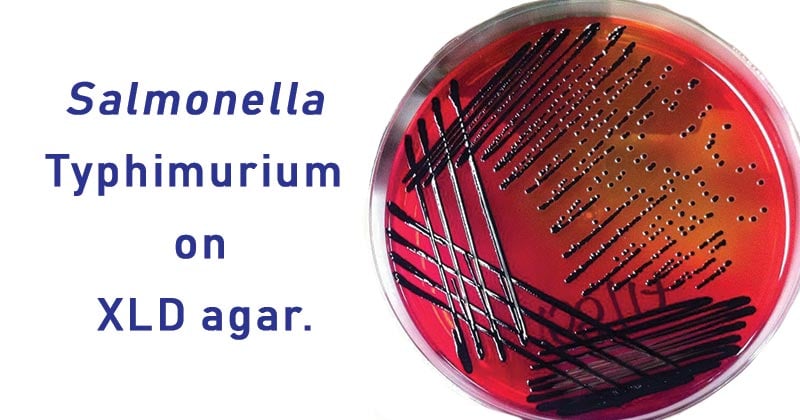Interesting Science Videos
What is XLD Agar?
Xylose Lysine Deoxycholate (XLD) agar is a selective growth medium used for the isolation of Salmonella and Shigella species from clinical samples and from food. XLD Agar was developed by Taylor for the differentiation, isolation, and identification of enteric pathogens, and to support the growth of more fastidious enteric organisms. XLD Agar was specially designed to allow the growth of Shigella species and is a proven medium for the isolation of this organism. It has also been found to be an excellent medium for isolating Salmonella species as well. It has a pH of approximately 7.4, leaving it with a bright pink or red appearance due to the indicator phenol red. Sugar fermentation lowers the pH and the phenol red indicator registers this by changing to yellow. Most gut bacteria, including Salmonella, can ferment the sugar xylose to produce acid; Shigella colonies cannot do this and therefore remain red. After exhausting the xylose supply Salmonella colonies will decarboxylate lysine, increasing the pH once again to alkaline and mimicking the red Shigella colonies. Salmonellae metabolize thiosulfate to produce hydrogen sulfide, which leads to the formation of colonies with black centers and allows them to be differentiated from the similarly colored Shigella colonies.
Composition of XLD Agar
| Ingredients | Gms/Litre |
| Yeast extract | 3.0 |
| L- Lysine | 5.0 |
| Lactose | 7.5 |
| Sucrose | 7.5 |
| Xylose | 3.5 |
| Sodium chloride | 5.0 |
| Sodium deoxycholate | 2.5 |
| Sodium thiosulphate | 6.8 |
| Ferric ammonium citrate | 0.8 |
| Phenol red | 0.08 |
| Agar | 15.0 |
Final pH (at 25°C) 7.4±0.2
Principle of XLD Agar
XLD Agar is both a selective and differential medium. The medium contains yeast extract, which provides nitrogen and vitamins required for growth. It utilizes sodium deoxycholate as the selective agent and, therefore, is inhibitory to gram-positive micro-organisms. Though the sugars xylose, lactose, and sucrose provide sources of fermentable carbohydrates, xylose is mainly incorporated into the medium since it is not fermented by Shigella but practically by all enterics. This aids in the differentiation of Shigella species. Sodium chloride maintains the osmotic balance of the medium. Lysine is included to differentiate the Salmonella group from the non-pathogens. Salmonella rapidly ferments xylose and exhausts the supply. Subsequently, lysine is decarboxylated by the enzyme lysine decarboxylase to form amines with reversion to an alkaline pH that mimics the Shigella reaction. However, to prevent this reaction by lysine-positive coliforms, lactose and sucrose are added to produce acid in excess. Degradation of xylose, lactose, and sucrose to acid causes phenol red indicator to change its color to yellow. Bacteria that decarboxylate lysine to cadaverine can be recognized by the appearance of a red coloration around the colonies due to an increase in pH. These reactions can proceed simultaneously or successively, and this may cause the pH indicator to exhibit various shades of color or it may change its color from yellow to red on prolonged incubation. To add to the differentiating ability of the formulation, an H2S indicator system, consisting of sodium thiosulphate and ferric ammonium citrate, is included for the visualization of hydrogen sulfide produced, resulting in the formation of colonies with black centers. The non-pathogenic H2S producers do not decarboxylase lysine; therefore, the acid reaction produced by them prevents the blackening of the colonies.
Preparation of XLD Agar
- Suspend 56.68 grams in 1000 ml distilled water.
- Heat with frequent agitation until the medium boils.
DO NOT AUTOCLAVE OR OVERHEAT. - Transfer immediately to a water bath at 50°C.
- After cooling, pour into sterile Petri plates.
- It is advisable not to prepare large volumes that will require prolonged heating, thereby producing precipitate, thereby producing precipitate.
Results of XLD Agar

| Organisms | Colony characteristics |
| Salmonella H2S positive | Red colonies with black centers |
| Shigella spp. and Salmonella H2S negative | Red colonies |
| E. coli | Large, flat, yellow colonies |
| Proteus spp. | Red to Yellow colonies |
| Enterobacter / Klebsiella | Mucoid, yellow colonies |
Uses of XLD Agar
- XLD Agar is a selective differential medium for the isolation of Gram-negative enteric pathogens from fecal specimens and other clinical material.
- It is especially suitable for the isolation of Shigella and Salmonella species.
- Microbiological testing of foods, water and dairy products.
Limitations of XLD Agar
- Some Proteus strains may give red to yellow colouration with most colonies developing black centers, giving rise to false positive reactions.
- Non-enterics like Pseudomonas and Providencia may exhibit red colonies.
- S. Paratyphi A, S. Choleraesuis, S. Pullorum and S. Gallinarum may form red colonies without H2S, thus resembling Shigella.
- Incubation in excess of 48 hours may lead to false-positive results.
- It is recommended that biochemical, immunological, molecular, or mass spectrometry testing be performed on colonies from pure culture for complete identification.

Great work. Thanks a lot brother .
Why the XLDA is heated? Not autoclaved??
This media contain heat labile components .
I LIKE YOUR WORK,I WONDER HOW I CAN GET UIN TOUCH WITH YOU AM MARGRET A MEDICAL LAB TECHNICIAN
You can contact us at microbenotes@gmail.com
it is good form of presentation